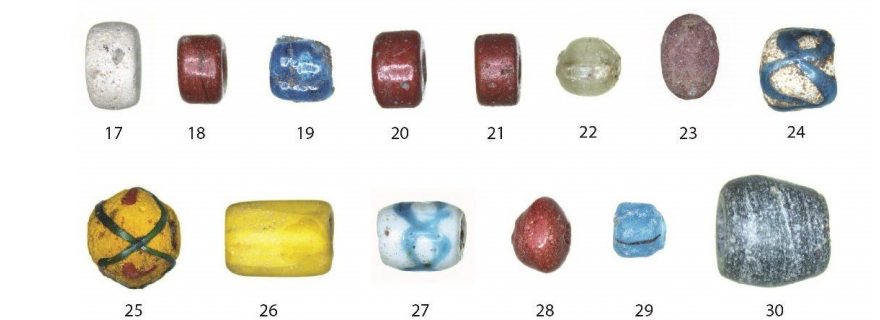On Beads and Boats: Merovingian beads travelling through time and space
What do beads and boats have in common? In Merovingian Europe, just about everything. Just like boats, Merovingian beads travelled through time and space, across huge distances, into other worlds and back again.
It is commonly known that boats played an important role in early medieval times. In an era in which rivers were the most important highways for transport, boats were indispensable. Water was the easiest way to travel, and boats connected worlds, carried peoples, beliefs and ideas, as well as pots, beads, grain and wine. Besides being a means to get from A to B, boats were used as symbols for travel between different spiritual worlds. We all know the examples of ship burials, suggesting a journey after death. When you think about it, this is not very surprising: waterways and coastlines are often associated with barriers and gateways to other worlds, and ships were the one means available to traverse them (Pye 2015).
Like boats in the early middle ages, people, places and things can be and represent several things at once. An object can be an heirloom, a functional tool, a reviver of memories and a piece of junk all at once. A symbol can have multiple meanings. Traditionally, a place like a coastline can be an unyielding barrier, and the gateway to other worlds, both literally and figuratively. When you look closely, everything is multiple things at once: it is all in the eye of the beholder. In this blog, I want to explore this idea for beads found by the thousands in Merovingian cemeteries (fig. 1). They lend themselves well for this topic, as they were both mass produced commodities and so special that they were deposited in graves at the same time.
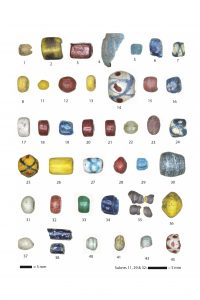

Merovingian beads
Hundreds of thousands of decorative beads have been deposited in inhumation graves across Europe dating between ad 400-750. When beads are excavated, they are often dismissed as meaningless trinkets. In the past few years, however, it has become clear that bead research has much more to offer. Beads are durable, portable, ubiquitous, and highly variable objects. They are also a means to gain a better understanding of mercantile and other networks that facilitated long-distance trade. For example, archaeometric analysis of Merovingian glass beads has demonstrated that in the fifth and sixth centuries, many monochrome glass beads were imported into Europe from the Near East, and even from as far away as India and Sri Lanka (Pion&Gratuze 2016). As hundreds of thousands beads are known from numerous Merovingian cemeteries in north-western Europe, beads seem to be a perfect material category to study early medieval exchange.
The world on a string
In a single string of beads found in a Merovingian grave, beads with provenances as varied as Europe, Egypt, the Near East and the Baltic are represented. Let me illustrate it with an example from the cemetery of Lent-Lentseveld near Nijmegen (fig. 2). This string of hundred-twenty-one beads was found around the neck of a young child in a grave that dates to the first half of the sixth century CE. Besides the necklace, other objects were deposited in the grave as well: a ceramic vessel, a glass beaker, a spindle whorl, some belt fittings and a bone disc (fig. 3).
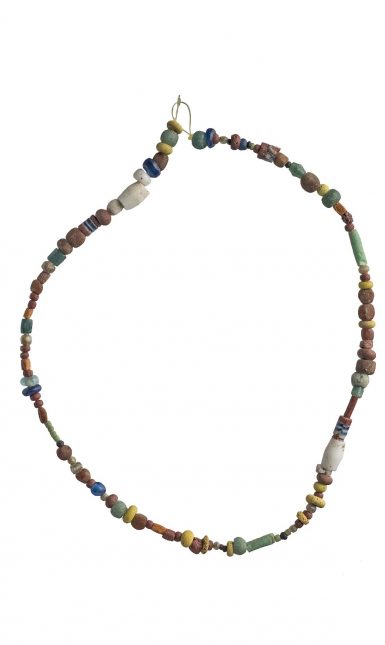

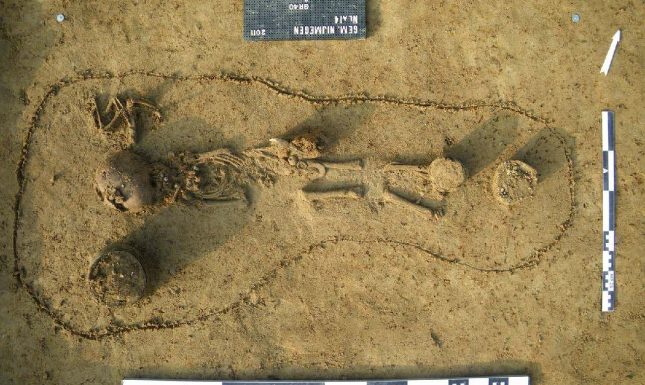

This necklace consists of hundred-and-six beads made of glass, one made of faience and fourteen made of amber. Beads of amber represent about ten percent of Merovingian beads, and the raw material for these was most likely imported from the Baltic (Langbroek 2018). The glass beads in this string were made with varying techniques. Thirty-three are wound beads, a technique that was used to produce beads at many locations across Europe. Sixty-six were made out of drawn, folded or perforated glass, most of which were made in the Near East, some in the Middle East and one in India. Lastly, five beads are so-called millefiori or mosaic beads (not all depicted), that were made in Egypt (for more info on Merovingian beads and their provenances, see Pion 2014).
Strikingly, around the neck of this dead child a myriad of connections with many different parts of the world is represented. Literally, this necklace represents the world as people then knew it on a string. What is perhaps even more surprising, for bead sets found in Merovingian cemeteries this is not even that uncommon. Nearly all bead sets from cemeteries contemporary to Lent, of which there are many in Europe, have such varying provenances. This display of overseas connections was not reserved for the very special dead only: whenever beads are found, they are found in about half of the graves in which women were buried (Langbroek 2016).
Traveling through Time and Space
The study of beads demonstrates that the Merovingian population of north-western Europe seems to have been remarkably well-connected. How did beads from such distant places come to be so well represented in Merovingian cemeteries? Most likely, they were piggybacking on boats travelling across the continent transporting perishable bulk goods such as wine, furs, grain or even slaves. These products and people may have been exchanged for Frisian cloth, salt, or horses. In the saint life of St Goar, Frisian merchants are mentioned going up and down the Rhine, also as middlemen shipping exotic and valuable goods (Lebecq 1983). They were using boats that could be beached anywhere, and indeed there are records of Frisian merchants in many places across the continent. No matter what was being transported, there was always room for a bag of beads. As such, the study of beads can serve as a blueprint for other exchanges that left no traces in the archaeological record.
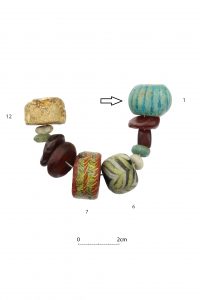

Besides covering huge distances, Merovingian beads were travelling through time as well. In many bead sets, beads that are much older than the grave itself can be found. For example, in a grave from the small Merovingian cemetery found in Uden, a string of beads was found that features a light blue bead made from faience (fig 4). This bead is a so-called Roman melon bead that was produced in Egypt centuries before it was deposited in this Merovingian grave. Melon beads occur time and again in Merovingian bead sets, and generally show a great deal of wear. As there are many ethnographic examples of beads featuring in intergenerational exchange (Sciama & Eicher 1998), it is not unthinkable that the Merovingian population was involved in similar practices; beads may have circulated in generational or intergenerational networks, being passed on between siblings or to daughters or granddaughters during rites of passage such as coming-of-age or marriage before leaving the parental house or settlement. In that way, a bead can become a gift, part of an inheritance, return into networks of exchange or be taken out of circulation through deposition in a burial. A lot of time may pass between acquisition and deposition of beads, as is clearly the case with melon beads.
Into other worlds and back again
The rather large amount of beads present in Merovingian society does suggest that at the start of their ‘lives’, beads may have been simple commodities. Then, through being exchanged, the very same beads may have gained enough significance for their wearers to motivate their role in funerary practices. It is very well possible that beads, once deposited in a grave, took on a different meaning than they had before their burial. As is demonstrated by my colleague Martine van Haperen, the Merovingian population had a very different take on the afterlife and dealing with their dead than we do nowadays. In lots of cemeteries, evidence for the re-opening of Merovingian graves within a generation after the initial burial has been found (Van Haperen 2017). During these re-opening practices, grave gifts (including beads) and human bones were retrieved from graves. As already touched upon above, the symbolism of ships in early medieval burials may suggest the idea of a journey after death. It seems likely that beads taken from graves were valued very differently than beads that had not undertaken such a journey to the next world.
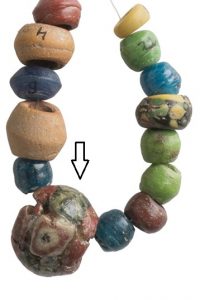

A possible example of a bead that has crossed the threshold into the afterlife on multiple occasions, can be found in a small farmyard burial ground in Dommelen in the Kempen region, that dates to the late seventh century (fig. 5). Amongst the beads found in one of the graves sits one large mosaic bead that is clearly out of time, as it is about 150 years older than the grave itself. Compared to the other beads, it has a battered and broken look. As in several earlier neighbouring cemeteries evidence for the re-opening of graves has been found (van Haperen 2017), it is plausible that this worn-out bead had been retrieved from an earlier grave. The bead may have been worn again for a while, before being finally deposited in the burial ground of Dommelen and sent off for its final journey.
Not just beads
In this blog I have demonstrated that Merovingian beads travelled through time and space, across huge distances, into other worlds and back again. They were both mass produced commodities and so special that they were deposited in graves at the same time. Beyond being convenient objects to study near global contacts in the early medieval world, Merovingian beads probably played a significant role in social (inter)generational networks. A simple thing like a Merovingian bead may have once been an insignificant object, but could carry tons of meaning at the same time. Still, without boats, they would not have gotten anywhere.
Further reading
Haperen, van, M., 2017: In Touch with the Dead. Early Medieval Grave Reopenings in the Low Countries (PhD thesis, Universiteit Leiden).
Langbroek, M.B., 2016: All that is Gold does not Glitter. A study on the Merovingian use and exchange of amber or northern gold in the Benelux and the German Lower Rhine area, Leiden (unpublished RMA thesis Leiden University).
Langbroek, M.B., 2018: Early medieval amber beads in Northern Gaul, in M. Kars/R. van Oosten/M. Roxburgh/A.A.A. Verhoeven (eds.), 2018: Rural riches & royal rags? Studies on Medieval and Modern Archaeology, presented to Frans Theuws, Zwolle, 105-109.
Langbroek, M.B., 2021: Beads and beadmaking in the early medieval settlement of Oegstgeest, in J. de Bruin/C. Bakels/F. Theuws (eds.), 2021: Oegstgeest A riverine settlement in the early medieval world system, Bonn, 278-293.
Lebecq, Stephane 1983: Marchands et navigateurs Frisons du haut moyen age, Lille.
Mannion, M., 2015: Glass beads from Early Medieval Ireland. Classification, dating, social performance, Oxford.
Pion, C./B. Gratuze, 2016: Indo-Pacific glass beads from the Indian subcontinent in Early Merovingian graves (5th-6th century AD), Archaeological Research in Asia 6, 51-64.
Pion, C., 2014: Les perles mérovingiennes: typo-chronologie, fabrication et fonctions ( PhD thesis, Université libre de Bruxelles).
Pye, M., 2015: The Edge of the World. How the north Sea made us who we are, London.
Sciama, L.D./J. B. Eicher (eds.), 1998: Beads and Bead Makers, Gender, Material Culture and Meaning, Oxford/New York.
© Mette Langbroek and Leiden Medievalists Blog, 2021. Unauthorised use and/or duplication of this material without express and written permission from this site’s author and/or owner is strictly prohibited. Excerpts and links may be used, provided that full and clear credit is given to Mette Langbroek and Leiden Medievalists Blog with appropriate and specific direction to the original content.


